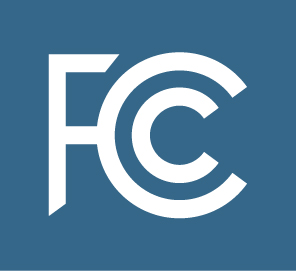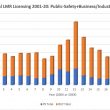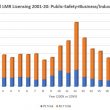LMR licensing activity improves from 2020, still behind pace of pre-pandemic lows
Land-mobile-radio (LMR) licensing activity in the public-safety and business-industrial sectors has increased from last year’s pandemic-influenced totals, but the number of LMR license applications during the first half of this year still trails the pace of all-time low totals established prior to COVID-19 hitting the U.S., according to FCC figures.
As of July 2—the 183rd day of the year, just beyond the halfway point in 2021—the FCC has received 1,479 applications from public-safety entities and 5,032 applications from business-industrial groups seeking new or modified LMR spectrum licenses, based on queries to the FCC’s online Universal Licensing System (ULS). Projected over the full year, this pace of LMR licensing activity would generate 2,949.9 public-safety licenses and 10,036.5 business-industrial licenses in 2021, if all pending licenses were approved by the FCC. These figures would exceed the 2020 LMR licensing activity—applications for 2,763 public-safety licenses and 9,461 business-industrial licenses—but they do not represent the kind of increases some industry officials had hoped for, given the reopening of the U.S. economy, federal stimulus funding, and the first significant T-Band activity in nine years.
Of the 1,479 public-safety applications for LMR spectrum licenses, 589 seek new spectrum licenses, while the remainder are asking to modify existing licenses. All but 62 of the public-safety applications (29 of which are new) in the ULS database already have been granted.
In contrast, the number of pending applications in the business-industrial arena is much more significant, with 1,302 of the 5,032 applications in the sector still awaiting FCC approval. Typically, at least 10% of pending applications are not granted. If that occurs again this year, it would mean that the current pace of business-industrial license applications likely projects to less than 10,000 for the second consecutive year, after exceeding this threshold during the previous 19 years of the online ULS database.
Similarly, the number of public-safety LMR license applications granted projects to be less than 3,000 for the second consecutive year, after surpassing the 3,000 mark in the previous 19 years of the online ULS database.
These 2021 licensing figures continue a disappointing trend for the LMR industry, which has seen LMR licensing decrease by about 70% since the peak numbers posted in 2012. Of course, those 2012 figures were inflated by the FCC’s narrowbanding mandate that took effect at the end of that year, but the decline in LMR licensing also has been significant after narrowbanding—since 2015, the public-safety licenses granted has decreased by about 30%, and the business-industrial figures have fallen by 45%.
LMR continues to be the primary technology used for mission-critical voice communications, particularly in the public-safety arena. However, various flavors of push-to-talk-over-cellular communications steadily have been making inroads within enterprises and in situations that require quick deployments and/or user flexibility, as was demonstrated repeatedly at temporary COVD-19 testing facilities that were established last year.















